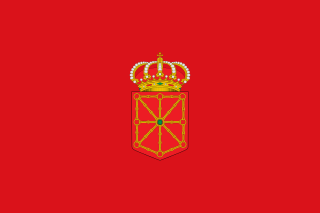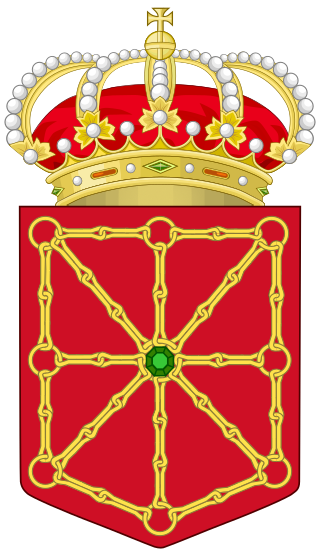
Navarre, officially the Chartered Community of Navarre, is a landlocked foral autonomous community and province in northern Spain, bordering the Basque Autonomous Community, La Rioja, and Aragon in Spain and Nouvelle-Aquitaine in France. The capital city is Pamplona. The present-day province makes up the majority of the territory of the medieval Kingdom of Navarre, a long-standing Pyrenean kingdom that occupied lands on both sides of the western Pyrenees, with its northernmost part, Lower Navarre, located in the southwest corner of France.

The Basque Country is the name given to the home of the Basque people. The Basque Country is located in the western Pyrenees, straddling the border between France and Spain on the coast of the Bay of Biscay. Euskal Herria is the oldest documented Basque name for the area they inhabit, dating from the 16th century.

Lower Navarre is a traditional region of the present-day French département of Pyrénées-Atlantiques. It corresponds to the northernmost merindad of the Kingdom of Navarre during the Middle Ages. After the Spanish conquest of Iberian Navarre (1512–24), this merindad was restored to the rule of the native king, Henry II. Its capitals were Saint-Jean-Pied-de-Port and Saint-Palais. In the extreme north there was the little sovereign Principality of Bidache, with an area of 1,284 km2 (496 sq mi) and a decreasing population of 44,450, 25,356.

Labourd is a former French province and part of the present-day Pyrénées Atlantiques département. It is one of the traditional Basque provinces, and identified as one of the territorial component parts of the Basque Country by many, especially by the Basque nationalists.

Fuero, Fur, Foro or Foru is a Spanish legal term and concept. The word comes from Latin forum, an open space used as a market, tribunal and meeting place. The same Latin root is the origin of the French terms for and foire, and the Portuguese terms foro and foral; all of these words have related, but somewhat different meanings.

Abaurregaina / Abaurrea Alta is a municipality and inhabited locality situated in the province and autonomous community of Navarre, northern Spain. It is situated some 70 km from the provincial capital, Pamplona. As of 2005 INE figures, the municipality had a population of c. 150 inhabitants.

Navascués is a town and municipality in the province and autonomous community of Navarre in northern Spain. It has a population of under 200.

Orcoyen is a town and municipality located in the province and autonomous community of Navarre, northern Spain, being part of Pamplona's metropolitan area. Its population currently stands at 3,637 inhabitants. Its population density is of 0.69 inhabitants/km2. This area is home to one of Spain's most industrious regions, which is Pamplona's metropolitan area; this has triggered a transition from an agricultural background, giving way to the automotive industry.

Oteiza or Oteiza de la Solana, is a village and a Spanish municipality of the Foral Community of Navarra, located in the merindad of Estella, in the Estella Oriental region, 51 km from the capital of the community, Pamplona. Its population in 2016 was 939.

Puente la Reina is a town and municipality located in the autonomous community of Navarre, in northern Spain.

Villamayor de Monjardín is a town and municipality located in the province and the autonomous community of Navarre, northern Spain.

Getaria is a coastal town located in the province of Gipuzkoa, in the autonomous community of Basque Country, in the northern part of Spain. This coastal village is located on the Urola Coast, with Zarautz to the east and Zumaia to the west.

The Parliament of Navarre or also known as Cortes de Navarra or Nafarroako Gorteak is the Navarre autonomous unicameral parliament.

Navarrete is a municipality of the autonomous community of La Rioja. Named a Conjunto Histórico-Artístico of Spain, due to its historical and monumental character. Navarrete is located between Logroño and Nájera on the French Way, the most popular path on the Way of St. James, a medieval pilgrim route. Currently, Navarrete is the only pottery centre in La Rioja, and it has been one of the most important centres in Northern Spain.

Navarra is a Spanish Denominación de Origen Protegida (DOP) for wines from the southern half of the autonomous community of Navarre. The vineyards are on the lower slopes of the Pyrenees as they descend towards the basin of the river Ebro.

The Salazar Valley is a valley in the east of the Foral Community of Navarre in Spain. It lies within the Merindad of Zangoza-Sangüesa and within that, the Comarca of Roncal-Salazar. The Sierra de Abodi, part of the Western Pyrenees, forms the natural boundary in the north. There is a ski resort in Abodi.
The Chartered Community of Navarre is divided in 12 regions —named eskualdeak in basque and comarcas in Spanish—, which are juridical figures constituted as local administrative divisions designed to provide local proximity services. They follow the ancient divisions of the Kingdom of Navarre, which include figures such as the merindade or the almiradio. Currently, Navarre is divided into 12 eskualdeak/comarcas (regions) and 4 azpieskualdeak/subcomarcas (subregions) since the 04/2019 Foral Law approved by the Barkos government on 2019. However, the process of dissolution of the old entities and creation of the new ones was stopped by the following Chivite government, making it today still unachieved, even though the eskualdeak/comarcas exist officially.

The coat of arms of Navarre is the heraldic emblem which for centuries has been used in Navarre. It was adopted as one of the official symbols of the Chartered Community of Navarre and is regulated by Foral Law 24/2003. It is commonly used by Navarrese municipalities in their own arms.
Subiza is a Spanish town located in the province and autonomous community of Navarre, belonging to the municipality of Galar, in northern Spain. Its population in 2014 was of 191 inhabitants (INE).

The Roncal Valley is a valley and mancomunidad in the very east of Navarre, bordering the autonomous community of Aragon to the East and France to the north. It is part of the Merindad of Sangüesa. The Ezka River, a tributary of the Aragón, flows from north to south through the center of the valley.




















